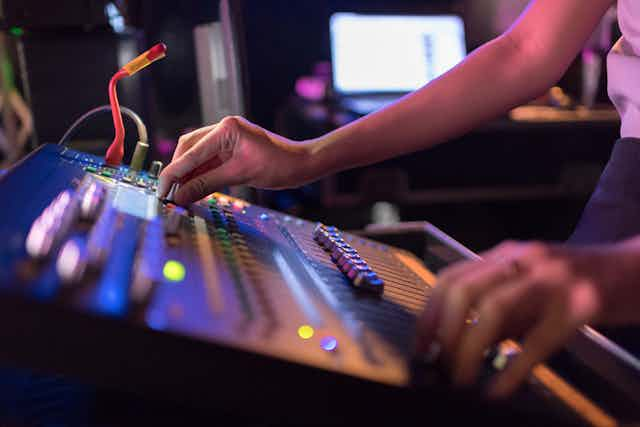Women are severely underrepresented in the fields of sound and music technology. This downward trend of women’s participation is reflected across the science and technology subject areas. My research has shown that we need to start addressing the problem as early as possible by inspiring girls at secondary school. That’s where a little box of tricks comes in.
In 2015, the organisation Women in Sound Women on Sound was established at Lancaster University as a space to showcase women’s contribution to computer music (the use of computer technology to compose and perform music), the sonic arts and sound studies. Since then, the network has collaborated with people from across the world to try and find innovative new ways to bridge the industry’s gender gap. What has emerged is that the move away from technology begins early in secondary school education. But at a series of workshops, teenage girls told us that they feel inspired when they see women working so confidently with technology.
In September, the network launched Activating Women in Sound in a Box – a physical and virtual toolkit to change how we teach young people about technology, music and sound. In the box are CDs by female composers of modern music, tools to build your own electronic instrument, and books such as Pink Noises: Women on Electronic Music and Sound by Tara Rodgers.
Students can learn about inspirational women like Daphne Oram – one of the central figures in the development of British experimental electronic music – and Delia Derbyshire. Oram declined a place at the Royal College of Music to become a “music balancer” at the BBC and became the co-founder and first director of the BBC Radiophonic Workshop. She is credited with the invention of a new form of sound synthesis called “Oramics” – one of the earliest forms of electronic sound synthesis. Derbyshire has been called “the unsung heroine of British electronic music” and is behind iconic music like the Dr Who theme.
An online toolbox
The network also developed an online box, with video tutorials by women who work in live sound engineering, electronics, sound design and composition. These women have created tutorials that look at women’s historic contribution to music technology, live coding and sound engineering. The website has an interactive space where you can find links to publications by women on everything from sound and society to women in punk. The box is a resource for teachers to use alongside the current curriculum that will put women in the frame when it comes to teaching music technology, engineering and computer coding.
Over the past decade, there have been a number of attempts to redress the growing exclusion of women from music technology industries. Groups like the Yorkshire Sound Women’s Network and websites like the Her Noise archive and the Delia Derbyshire Archive were created to highlight women’s historic and contemporary contribution to music technology.
There have also been a number of research projects and organisations developed to create spaces of learning and inclusivity in order to get girls thinking about careers in music engineering and computer music. Each organisation and activity is attempting to do what the education system seems to be failing at: getting girls interested in any combination of STEAM – Science, Technology, Engineering, Arts and Maths – subjects for future careers.
The gender gap
Georgina Born and Kyle Devine highlighted the “highly (male) gendered digital music field” in which approximately 90% of music technology students are currently white males. The outcome is that the creative field becomes dominated by male practitioners, male lecturers and male authors. This means young girls don’t have role models or people they see as representing them. But just because women don’t always attend music technology programs, aren’t always visible at music events and sometimes don’t even appear on the curriculum, does not mean they’re not there.
The box is one way to put women, who work in, and have contributed to the music technology industry – and other sound related areas – back into education. It makes women visible to all students. The box is a resource that teachers can use throughout the year, not just a one-off project. The WISWOS network will continue to add more material to the box, including video tutorials and online learning tools as feedback comes in from schools. In this way, seeing women teaching you about any area of technology won’t be a rare event, it might even become part of the norm in education.

